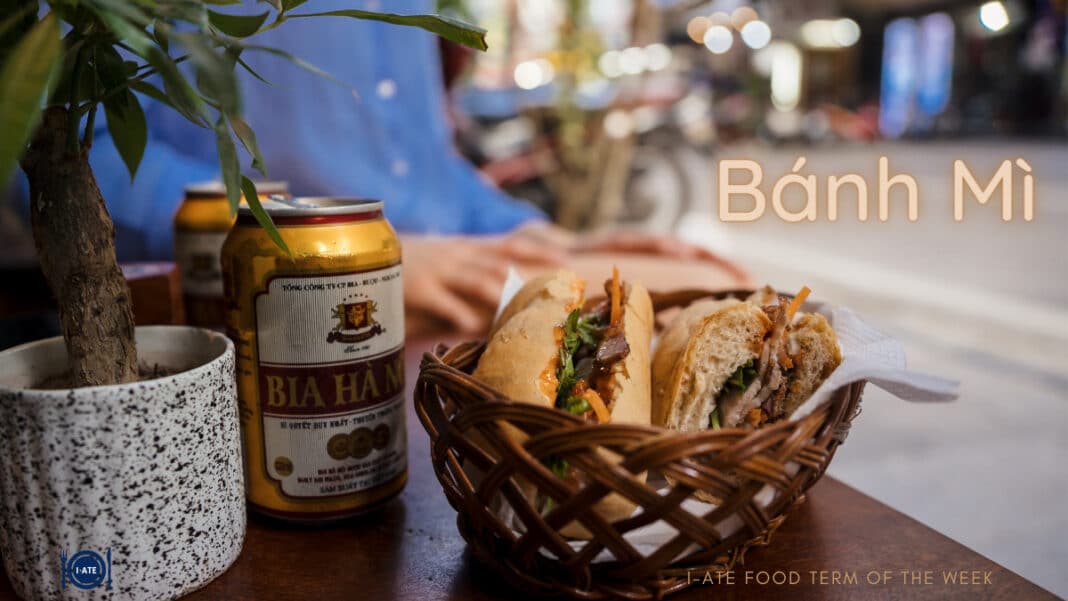This week’s I-ATE food term is about the Vietnamese national sandwich bánh mì. Bánh mì is a Vietnamese sandwich, consisting of an elongated bread bun sliced halfway and filled with an assortment of meats, pickled vegetables, coriander, mayonnaise or chili. Bánh mì is mainly eaten for breakfast or as a snack and is usually sold by street vendors.
It may be surprising to see that a bread-based snack is so ubiquitous in a country where rice is the staple food crop. The origins of bánh mì can be found in the French colonial rule of Vietnam, which lasted from 1887 to 1959. During this period, the French introduced baguettes to Vietnam and over time, locals started filling them with an eclectic mixture of Vietnamese, French and French-inspired ingredients.
The etymology of the word bánh mì
The Vietnamese word bánh is often translated as ‘cake’ or ‘bread’. The word bánh can refer to a wide variety of foods, including sandwiches, dumplings, and pancakes. The word bánh therefore appears in many Vietnamese dishes. Bánh bao, for example, translates to ‘bun bánh’ and is the name for filled steamed dumplings; bánh bo, or ‘cow bánh’ are chewy sponge cakes.
Mì is the Vietnamese word for ‘wheat’, so bánh mì can be translated as ‘wheat banh’. Bánh mì can refer to just the bread or the sandwich. There are some claims that bánh mì comes from the French term for soft bread, pain de mie. However, the fact that the word bánh has been in the Vietnamese vocabulary since the 13th century makes this a rather unlikely etymology.
The history of the bánh mì
French missionaries and traders had been travelling to Vietnam from the 17th century onwards. However, after increasing hostilities between Vietnam’s reigning dynasty and European missionaries, France’s decision to invade Vietnam fell in 1857. In 1887, Vietnam, along with modern-day Cambodia and Laos, was integrated into the French colonial empire and called l’Union Indochinoise or Indochina. During this period, French traders set sail for Vietnam and with them came French food: milk, butter, cheese, chocolate, charcuterie and the quintessential baguette. French imports like Laughing Cow cheese and Maggi sauce quickly became staples in Vietnamese cuisine that endure to this day. French soldiers and officials stationed in Vietnam ate baguette sandwiches with ham, butter, cheese, pâté, and cornichons. The Vietnamese called these baguette sandwiches bánh tây, or ‘French bánh.’
In the early 20th century, World War I made many of the French stationed in Southeast Asia return to France; this left their imported European goods on the local market at a reduced price. It was around this time that the Vietnamese started filling baguettes with a mixture of French and local ingredients. First, they used cold cuts of ham, pork, pâté or sausages with pickled radishes, carrots, or cucumbers. Later, mayonnaise was added, as were coriander, chili, and Maggi or soy sauce. To further differentiate these sandwiches from the baguettes the French ate, the name changed from bánh tây to bánh mì.
The bread too, changed its shape from the long baguette shape to a shorter, oval shape. Bánh mì is also lighter and fluffier than a traditional French baguette. While some ascribe this to the fact that rice flour is often mixed in with the wheat flour, rice flour actually does not rise very well. The consistency of bánh mì is hence likely the result of dough enhancers, such as ascorbic acid. Bread goes bad quickly in Vietnam’s hot and humid climate. Therefore, in order to ensure a fresh supply of bread, bánh mì has to be baked throughout the day.
In principle, there are no limits to the kind of fillings that go into bánh mì and ingenious sellers keep finding new ways of innovating this sandwich. In addition to being sold in food stalls all over Vietnam’s cities, the Vietnamese diaspora has been spreading bánh mì far and wide, and it has been enthusiastically embraced by foodies all over the globe.
How to make bánh mì
Nguyen, A. 2009. Master Banh Mi Sandwich Recipe. [ONLINE]. Available at: https://www.vietworldkitchen.com/blog/2009/06/banh-mi-sandwich-recipe.html [Accessed: 07/03/2021].
References
Britannica. The Conquest of Vietnam by France. [ONLINE]. Available at: https://www.britannica.com/place/Vietnam/The-conquest-of-Vietnam-by-France [Accessed: 07/03/2021].
Roads and Kingdoms. 2016. [ONLINE]. Available at: https://roadsandkingdoms.com/2016/the-sandwich-that-ate-the-world/ [Accessed: 07/03/2021]
Vu Hong Lien. 2016. Rice and Baguette: A History of Food in Vietnam. London: Reaktion Books. Available at: https://books.google.lu/books?id=UJGEDQAAQBAJ&pg=PT147&redir_esc=y#v=onepage&q&f=false [Accessed: 07/03/2021].
Wikipedia. Bánh Mì. [ONLINE]. Available at:https://en.wikipedia.org/wiki/B%C3%A1nh_m%C3%AC [Accessed: 07/03/2021].
Photo by Flo Dahm on Pexels.

Written by Janna Mack. From Luxembourg, she has degrees in Linguistics, Education, and Translation from Glasgow University.

